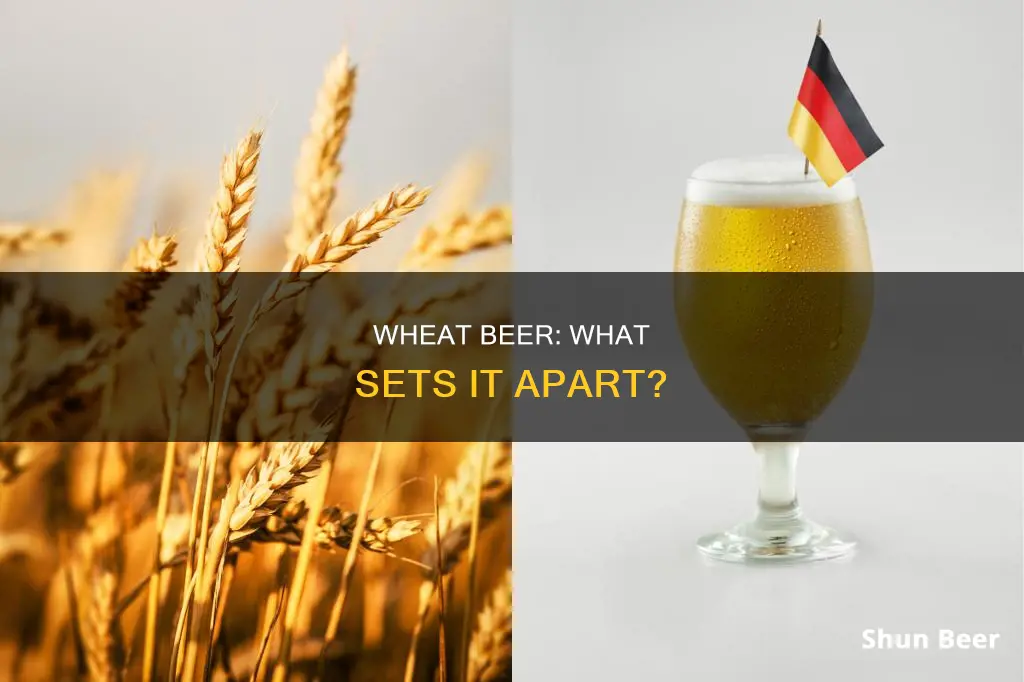
Wheat beer is a category of beer that originated in Bavaria, Germany. It is typically a top-fermented ale, with at least 30% wheat in the brewing process, and comes in a variety of styles. The most well-known wheat beer is Hefeweizen, a refreshing German style that's popular worldwide. Wheat beers are usually light in colour, low to medium in alcohol content, and can be cloudy or clear. They are often brewed without hops, tend to lack bitterness, and are easy to drink.
What You'll Learn

American Wheat Beer
The hop character of American wheat beers can vary from low to fairly high, but most examples are moderate in bitterness, with IBUs ranging from 10 to 35. While some versions have no hop character, others showcase noticeable citrus, spice, or floral qualities.
It is important to note that American wheat beers differ significantly from German Hefeweizens, which are known for their clove and banana flavours. American wheat beers do not exhibit these flavours and instead offer a more subdued fruitiness, with a clean and crisp finish.
Some well-known examples of American wheat beer include Widmer Hefeweizen, Oberon from Bell's Brewery, and Gumbelhead from 3 Floyds Brewing Company.
Blue Moon Beer: Wheat or Not?
You may want to see also

German Wheat Beer
The aroma and flavour of German wheat beer come largely from the yeast and are fruity (banana) and phenolic (clove). The intensity of these flavour qualities varies depending on the brewer, but the two are most commonly balanced. The soft, somewhat bready or grainy flavour of wheat is complementary. German wheat beer is best served in a weizen vase, a large curvaceous glass which showcases the beer's beautiful glow and its large, persistent foam cap.
Wheat Beer Allergies: Understanding the Connection and Symptoms
You may want to see also

Belgian Wheat Beer
Wheat beer is a category of beer that originated in Bavaria. It is typically a top-fermented ale, with at least 30% wheat in the brewing process, and comes in a variety of styles. The two main varieties are German Weizenbier and Belgian Witbier.
Belgian Witbier is a top-fermented beer, traditionally brewed mainly in Belgium and the Netherlands. It is also known as "white beer" because the suspended yeast and wheat proteins cause the beer to look hazy or white when cold. It is typically brewed with coriander and orange peel, and other herbs and spices may be added. Witbiers are usually cloudy and have a fruity, spicy character. They are also known for their generous foamy heads.
Wheat in IPA Beer: What You Need to Know
You may want to see also

Bavarian Wheat Beer
The most common variety of Bavarian wheat beer is hefeweizen, which is bottle-conditioned and unfiltered, giving it a cloudy appearance. The prefix "hefe" means yeast in German, indicating that the beer is served with its yeast. This variety typically has a standard strength of about 5% alcohol by volume (ABV).
Other types of Bavarian wheat beer include kristall weizen, a filtered version that is clearer and more mellow in taste; dunkelweizen, a dark wheat beer made with dark malts that deepen the colour and add notes of caramel, raisin and chocolate; and weizenbock, a stronger version of dunkelweizen with an ABV of around 7-8%.
Asahi Beer: Wheat-Free or Not?
You may want to see also

Wheat Beer and Lagers
Wheat beer is a category of beer that typically uses a top-fermenting process and includes a large proportion of wheat in the brewing process—at least 30% and often more. The most well-known wheat beer is Hefeweizen, a refreshing German style that's popular around the world. Wheat beers are usually light in colour, low to medium in alcohol content, and can be cloudy or clear. They may be brewed with or without hops, and they tend to lack bitterness, making them easy to drink. Wheat beers are known for their fruity and spicy flavours, with hints of banana and clove. They are often served in a flute or vase glass, and the pour is important to create a generous foamy head.
Lagers, on the other hand, are bottom-fermented and can be made with corn, barley, rice, or a combination of these grains. They have a wider range of colours and styles, from pale varieties like Pilsners to dark amber styles like dunkels. Lagers can have more hop character than wheat beers, and they lack the foamy head typically found in wheat beers. Lagers are typically light and malty in flavour, and they are often a popular entry point for new beer drinkers as they are clean and consistent in flavour.
While wheat beers are usually top-fermented ales, there is some variation within the category. For example, Berliner Weisse, a German style, is a sour and cloudy wheat beer with a very low alcohol content that is often flavoured with fruity syrups. Witbier, a Belgian style, is made with unmalted wheat and spiced with coriander and orange peel, giving it a subtle spicy note.
Wheat Beers and Psoriasis: A Cloudy Concern?
You may want to see also
Frequently asked questions
Wheat beer is any beer made with at least 30% wheat, which is a much higher proportion than other beers that are primarily made of barley, rye, or adjuncts like rice and corn. Wheat beers are typically light in colour, low to medium in alcohol content, and can be cloudy or clear in appearance.
The first wheat beers started in Germany and have since branched off into many different varieties, including Hefeweizen, Dunkelweizen, Weizenbock, Witbier, Berliner Weisse, and American Wheat.
Hefeweizen is a Bavarian style that is light in colour and cloudy. The yeast used for hefeweizens adds banana, bubblegum, and clove notes to the beer. Dunkelweizen is a slightly darker version of Hefeweizen, with added caramel and roasted notes. Weizenbock is a stronger Hefeweizen with more fruit and malt flavours and a slightly higher alcohol content. Witbier is a Belgian style wheat beer with similar banana, bubblegum, and clove notes to Hefeweizen, as well as flavours of orange peel and coriander. Berliner Weisse is a northern Bavarian style that is light and sour, often mixed with fruit. American Wheat is the American version of German wheat beer and is generally lighter and more adaptable, with hoppy versions also available.
Wheat beer is typically a top-fermented ale, with the yeast fermenting on the top. The yeast and wheat proteins are not filtered out of the finished beer, which gives wheat beers a hazy, sometimes opaque appearance.







